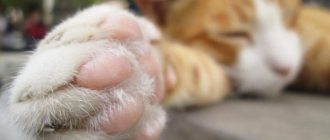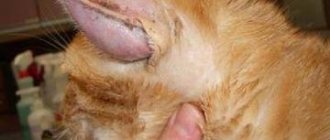- home
- Symptoms
- Paw failure in dogs and cats
The phrase “paws fail” usually refers to two main syndromes of impaired support ability of an animal. Paresis is a decrease in muscle contractility of one or more limbs. Paralysis is the complete absence of motor activity in one or more limbs. Also, often by this “symptom” owners mean other pathologies associated with the lack of motor activity of the animal.
Let's try to analyze those clinical conditions of the animal that owners most often treat, saying “the paws have given up”:
- The cat does not support itself on one or more limbs. Most often these are the pelvic limbs, sometimes only the forelimbs, or all four. In this case, the paws can be either completely relaxed or, conversely, hypertonic.
- The cat leans on all its limbs, but there is a disturbance in motor activity and “drags its paws.”
- The cat is lying down, and when you try to put it on its feet, it loses coordination in space and falls.
- The cat is lying down, and when you try to stand it, it immediately falls or lies down.
Why does a cat limp on his front leg: injury
As already mentioned, it is for this reason that a cat begins to limp on its paw most often. If the owners notice that it is difficult for their pet to step on its front paw, they should simply remember if anything has happened recently that could cause the injury. A cat may limp, for example, after an unsuccessful jump. Also, an animal’s paw may begin to hurt after someone steps on it, pinches it in a door, etc. In addition, quite often a similar problem is observed in those cats that are allowed to walk outside. A pet can get injured from other animals, after an unsuccessful jump, etc.
Lameness due to injury can range from mild to severe. In any case, if such a problem is discovered, your pet should be examined first. If the lameness is caused by an injury, a wound or swelling will likely be found on the paw. In this case, the animal owner should just wait a day. Most likely, the cat's injury, if he can still step on his paw, will go away after this time.
If the cat does not stop limping after 24 hours, you should take him to the veterinarian. The doctor will examine the animal, make the correct diagnosis and prescribe treatment.
The reasons why the cat began to limp on its front leg could be:
- cuts and punctures;
- fractures and dislocations;
- splinters.
Also, a cat, for example, can break a claw if it jumps unsuccessfully. In this case, the animal will subsequently experience quite severe pain for a long time and, accordingly, will begin to limp.
Treatment method and prognosis
Many pet owners are convinced that if their cat is paralyzed, the only humane way to put it out of its misery is euthanasia. This is only partly true. Indeed, if the condition is serious, then in order not to torment the cat, it is wiser to euthanize it. However, this measure is considered as an extreme measure.
If it is possible to identify the cause that provoked the paralysis, treatment is aimed at eliminating it, and, perhaps, the pet will be cured even without consequences. One or more operations at the veterinary clinic may be required, followed by a long recovery period.
Surgery is required for hernias and some injuries, such as when bone fragments protrude from the wound.
In addition, depending on the etiology of paralysis, the veterinarian prescribes sedatives, non-steroidal anti-inflammatory drugs (Rimadyl, Carprodil, Flexoprofen), anticoagulants (Clopidogrel, Heparin, Aspirin), and antibiotics to relieve pain. If the animal experiences severe pain, the use of opioid drugs (Fentanyl, Hydromorphone) cannot be ruled out.
For inflammatory processes and injuries, steroidal anti-inflammatory drugs are indicated. Metipred, which is administered by drip, has proven itself well. For tick bites, treatment is etiotropic.
Strengthening therapy includes the use of vitamins, in particular group B, which help restore damaged peripheral nerve endings.
If you become dehydrated, you need to replenish lost fluid using a dropper. If the animal has difficulty breathing, oxygen therapy is necessary.
The prognosis for complete or partial paralysis is variable, depending on many reasons - the age and condition of the animal, the degree of damage, etc.
Arthritis and arthrosis
This problem usually occurs in fairly old animals. In this case, lameness, of course, does not appear suddenly. At first, it becomes only slightly difficult for the pet to step on its foot. Then the problem gets worse.
If a cat has arthritis and is limping on its front leg, what should you do in this case? If there is such a problem, your pet will need to be shown to a specialist. Unfortunately, it is almost impossible to cure arthritis or arthrosis in old animals. The doctor will most likely prescribe only maintenance therapy.
Elbow dysplasia
This disease occurs in both young and old cats. Unfortunately, purebred animals are especially susceptible to it. Cattery owners often use this method of breeding expensive cats as inbreeding. In this case, kittens are born with pronounced breed characteristics. However, inbreeding significantly increases the risk of offspring developing hereditary diseases. One of these ailments is elbow dysplasia.
Signs of this disease can appear in a pet at a very early age. However, lameness in a cat with this problem becomes most noticeable at 2-3 years of age. Of course, such animals should not be allowed to breed. Also, the cat should definitely be taken to the veterinarian.
Like arthrosis, it is unlikely that it will be possible to cure dysplasia in a pet. However, the doctor will still choose a treatment regimen that will make the cat’s life more comfortable. The main symptoms of this disease in cats, in addition to lameness, are:
- crunching sounds when moving;
- X-shaped curvature of the limbs;
- stiffness of movement when standing up.
Osteomyelitis in cats
If a domestic cat is limping on its front leg, this may also indicate that it has developed this dangerous disease. The disease in this case also manifests itself gradually. Osteomyelitis is a disease associated with bone necrosis, accompanied by a purulent-inflammatory process.
Most often, this unpleasant disease occurs in cats under the age of 2 years. At the same time, pets of the Persian breed are considered the most susceptible to it. Veterinarians explain this by hereditary predisposition. Osteomyelitis is usually treated comprehensively - through surgery, as well as medications.
Causes and predisposition
Arthritis results from a wide variety of causes. Orthopedists say the main reason is advanced age.
. A long life leads to a decrease in the elasticity of the connective tissue and a deterioration in the motor activity of the front and hind legs. Malaise in older pets most often manifests itself in the form of dysfunction of the shoulder or elbow joints. After 10 years of life, the disease affects about 90% of cats.
Another common cause is genetics.
. This applies to breeds that are the result of unnatural selection. Modern representatives turned out to be especially predisposed to pathologies of the musculoskeletal system. Representatives of fold-eared breeds especially suffer from this problem - they are prone to hereditary anomalies in the formation of cartilage cells.
Fall from a great height
, getting hit by a car, or a fight with dogs is almost always accompanied by bruises, subluxations, sprains, and fractures. Such tissue damage to the musculoskeletal system causes inflammation and then the development of traumatic arthritis in cats.
Birth injury
also leads to deformation of the hip joint and further development of the disease. Extra pounds on a cat put no less strain on the joints: they increase friction and reduce fluid volume, which provokes connective tissue diseases.
Rheumatoid arthritis is most often caused by autoimmune diseases
. Destruction occurs due to the synthesis in the body of chemicals that destroy cartilage tissue. The disease affects almost all bones. It is sometimes caused by acromegaly, which is associated with an increase in the formation of growth hormone, which leads to irreversible processes.
Metabolic disease
causes the development of metabolic arthritis in cats. Thus, a deficiency of calcium or phosphorus, an incorrect ratio of these elements leads to disruption of the structure of bone tissue and a large number of osteochondral lesions. Another ailment - hemochromatosis (pigmentary cirrhosis) - contributes to the development of polyarthritis due to excessive accumulation of iron in the body of a pet.
Infectious strains
of various etiologies are dangerous for bones: these are viral, bacterial, fungal microorganisms. Pathogens are the main factor in the development of purulent arthritis. Polyarthritis is often caused by viral flu, calcivirus, and hepatitis.
Provoking factors include:
- incorrectly composed diet;
- weakened immune system;
- excessive physical activity;
- frequent hypothermia;
- unsanitary content.
When purchasing a pet, it is important to create all the necessary conditions to reduce the number of negative factors affecting its health.
Lameness due to infection
If the cat begins to limp on its front leg, it may have become infected with calcivirus. This disease of an infectious nature is very easily transmitted from a sick animal to a healthy one. For prevention, many cat owners vaccinate them against this disease. Animals that have not been vaccinated can become ill with calcivirus very easily.
In addition to lameness, signs of this disease may include:
- breathing problems;
- conjunctivitis;
- nasal discharge;
- damage to the paw joints;
- the presence of ulcers on the mucous membranes.
This disease causes inflammation of the anterior joint chambers. This is why the cat is limping on his front leg. What should owners do in this case? If you have calcivirosis, the animal should, of course, be shown to a specialist. Treatment in this case is complex - therapeutic and symptomatic.
Another infection that can cause lameness in a cat is a fungus. In this case, dermatophytes often affect not only the animal’s pads or its skin, but also its claws or joints. Lameness in cats in this case develops due to inflammation.
Patient care
An extremely unpleasant ailment, which causes not only pain, but also great inconvenience to the cat, requires increased attention from the owner and all family members. In addition to medications, the patient must be provided with comfortable living conditions and maximum care.
Arrangement of resting and feeding areas
You should start with a bed, which should be medium soft and quite spacious. The sleeping place should not be placed at a height, as the patient risks falling and receiving additional injuries. The best place for placement is the floor. However, you need to place the bed so that the cat is warm and there are no drafts below.
Bowls with food and water are placed near the crib. This is also done for the safety of the patient. You need to buy a tray with low walls so that you don’t have to lift up the highly injured legs. The filler used is small, it is poured in a thin layer. Then the cat will be able to fit comfortably in it.
Some felines like to sleep at heights. This is extremely dangerous, so it is worth blocking the path to the closet, window or refrigerator with boxes so that your mustachioed friend cannot jump into his usual place. Due to the constraint of movements, it is difficult for the pet to practice hygiene, so you need to comb the cat at least 2 times a week and trim the tips of the claws.
Painful sensations do not allow the mustachioed friend to enjoy communication with the owner. Indeed, the manifestation of affection in the form of hugs, throwing up, lifting by the paws is now under the strictest prohibition. Active games, fun and pranks with the patient are also prohibited.
Diet as the key to joint health
In addition to the measures listed, it is important to adhere to a special diet. This is especially necessary for individuals who are obese. Typically, the veterinarian recommends special medicinal industrial wet or dry food of premium class and higher, or natural, complete food with low calorie content. The menu should include:
- lean meats: chicken fillet, turkey, veal, beef, rabbit;
- sea, lean fish with a small number of bones;
- fermented milk products with low fat content or completely fat-free;
- boiled, chopped vegetables;
- cereals cooked in the form of porridge in water;
- cartilage, fresh gelatin broths.
You cannot offer cats food from the owner's table, tubular bones, sweets, salty or smoked foods, or milk.
Pretense
Sometimes it happens that the animal has no visible injuries, but the cat still limps on its front leg. The reason in this case may simply be the nature of the animal. A pet whose paw is slightly pinched or, for example, stepped on, may be offended. In this case, the cat, even if it does not feel any discomfort in its paw, begins to limping demonstratively only in order to express its indignation to its owners.
If the lameness is simply emotional, there will most likely be no damage to the animal's paw. Moreover, after a couple of hours the cat will get tired of playing, and he will stop limping.
In what cases should a cat be taken to the veterinarian?
When is specialist help needed? When the animal exhibits at least one of the following symptoms:
- the cat cannot walk at all or moves with great difficulty;
- when you touch the paw, the pet meows and abruptly pulls it away;
- the cat does not step on its paw, tucking it in when moving.
It is also worth visiting a specialist if the cat’s lameness is accompanied by loss of appetite, high fever, increased fatigue, lethargy or aggression. These are already very alarming symptoms.
Diagnostics in a veterinary clinic
Diagnostics is carried out comprehensively. First, the veterinarian examines the animal, conducts tests for tendon and neurological reflexes, and feels the paralyzed limbs. It is necessary to understand whether the cat feels touch, is in pain, or is no longer able to respond to stimuli.
Necessary diagnostic methods for paralysis include blood tests, urine tests, ultrasound of internal organs, MRI of the brain, X-rays, and Doppler sonography. If an infection is suspected, perform a bacteriological analysis.
The cat is limping on his front leg. What to do in this case, how to provide first aid to your pet?
As already mentioned, a limping animal should be left alone for one day and then taken to a veterinarian. Also, if a bruise is revealed during examination, you can apply cold to the affected area for 1 minute, wait 20 seconds and apply again for 1 minute. This operation should be repeated for 5 minutes.
If the owners suspect that the cat has a fracture, he needs to try to fix the paw. In this case, the animal must be taken to the clinic in an immobilized state. You can also try to provide first aid to a cat if he has a minor wound. In this case, the affected area must be carefully cleaned from dirt with a cloth soaked in soapy water. After this, the wound should be treated with furatsilin solution and the animal should be taken to the veterinarian.











